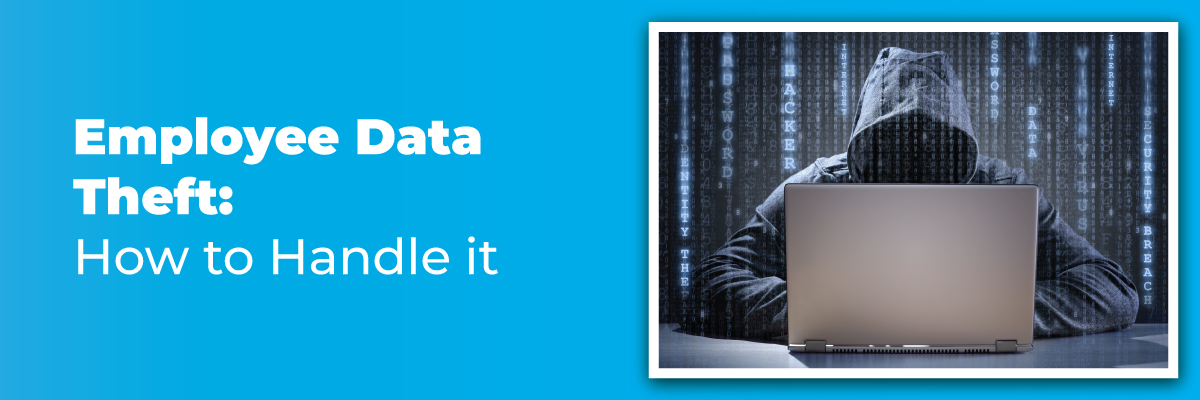How Do You Handle Employee Data Theft?

How Do You Handle Employee Data Theft?
When we hear the word “cyber threat,” we immediately think of hackers, trojans, phishing emails, and ransomware. While businesses should invest in efforts to prevent these external dangers from infiltrating their systems, there is another, far more prevalent hazard that is sometimes overlooked: employee data theft, especially when it comes to departing staff.
The insider threat posed by retiring employees is frequently disregarded. One out of every four departing employees steals data, which can be due to negligence or deliberate intent. In each situation, firms suffer negative consequences, ranging from a loss of competitive advantage to penalties for failing to meet cybersecurity regulations.
Insiders are a massive threat to your company’s security. The Verizon Data Breach Investigations Report found that 30% of all cyber-security incidents come from malicious insiders, which is rising! In 2020 alone, there’s an increase of 47%. It would be best if you could prevent these problems before they arise. Still, unfortunately, there’s not always room on the timeline for everything—especially when it comes down to protecting against human error or mistakes made by loved ones who have access rights within their department.
Why Do Employees Steal Data on Their Way Out?
Employee turnover is inevitable. No matter how much you invest in your team, people will move on to new opportunities at some point. And while most employees will leave without incident, there is always the risk that someone will try to steal company data on their way out the door. There are a few reasons why this might happen.
- A disgruntled employee may try to take revenge by taking sensitive information with them.
- An employee who is leaving for a competing company may try to take customers’ or proprietary data to give their new employer a leg up.
- An employee careless with data security may accidentally leave behind sensitive files.
No matter the reason, it’s essential to have strict policies to prevent data loss when employees leave your company. You can help protect your business from the risks of employee turnover by taking a few simple steps.
 How to Prevent Data Theft from Employees?
How to Prevent Data Theft from Employees?
Protecting sensitive data against insider threats and data theft is a broad topic that touches on almost every aspect of data security. It might be difficult to distinguish between what we consider an insider threat and a threat from outside the company.
1. Implement Zero Trust Security
A zero-trust security strategy is one in which organizations do not automatically trust any user, device, or system -inside or outside the network perimeter. Instead, they verify every request and connection before granting access to data and resources. This verification process can include authenticating the identity of users, assessing the risk of devices and systems, and authorizing the requested access. Organizations can improve their security posture by adopting a zero-trust approach and better protecting their data against emerging threats. Implementing a zero-trust security strategy does require some initial investment, but the benefits far outweigh the costs.
2. Give Limited Access
Only a few people should have access to employee data. This will limit the spread of information if there is a data breach. Handling employee data theft becomes much easier if there is limited access to the data. Also, if you have a process for handling data breaches, it is much less likely that your company will be the victim of a data breach.
- Educate your employees on the importance of keeping their passwords safe and secure.
- Have them change their passwords every few months.
- Install security software on all company computers.
These are just a few ways to help prevent employee data theft.
3. Plan Exit Interviews
In an exit interview, you can ask questions about how the employee plans to use company data after leaving and remind them of any confidentiality agreements they may have signed. You can also explain the consequences of stealing company data, such as their new employer’s legal and disciplinary actions. By conducting exit interviews, you can help deter employees from stealing company data and prevent them from taking advantage of your company’s information.
4. Creating an Anti-Theft Policy
In today’s age of technology, data theft is a growing concern for businesses of all sizes. Employees with access to sensitive data can easily copy or download it onto a portable storage device and take it with them when they leave. Once the data is out of your control, it can be used for identity theft, fraud, or other malicious purposes. To protect your business and your customer’s information, it’s essential to have a clear and concise anti-theft policy in place.
Your anti-theft policy should spell out what types of data are considered sensitive and off-limits for removal from the premises. It should also state the consequences for employees who violate the policy. In some cases, you may want to consider instituting a “clean desk” policy, which requires employees to completely clear their desks of all papers and personal belongings at the end of the day. These proactive measures can help deter data theft and safeguard your business against this growing threat.
5. Revoke Privileges and Credentials After Termination
When an employee is terminated, it is essential to take steps to prevent them from accessing company data. One way to do this is to revoke their privileges and credentials. This will prevent them from logging into company systems or accessing sensitive data. Additionally, it is essential to change any passwords to which the employee has access. This will ensure they cannot access any account or system they should not have access to.
Finally, it is essential to monitor any activity on company systems for any suspicious activity. If there is any activity that appears to be unauthorized, it can be investigated and dealt with appropriately. By taking these steps, you can help prevent employee data theft and protect your company’s information.
Final Words
It’s critical to ensure that everyone understands their role in keeping an eye on how their coworkers act. Introducing a system that allows employees to report questionable conduct might be an excellent idea anonymously. Finally, remember that no data loss prevention technique is 100% effective, so having a tried-and-true incident response plan is essential. However, if an employee lost your data, Protected Harbor would be an excellent solution for retrieving it.
Protected Harbor secures your endpoints and network and is a step ahead with proactive monitoring. We continuously watch for data interchange and how they are shared and stored. Regular user access and credentials updates are also a part of our process. And to check all the boxes, isolated backup, recovery, and an incident response plan tailor-made to your organization’s needs. Employee awareness training is equally essential when it comes to data security. Handling employee data theft is not so easy. That’s why you should call in for help and get a free IT audit, pen-testing, and data theft check today. Call Protected Harbor today.


